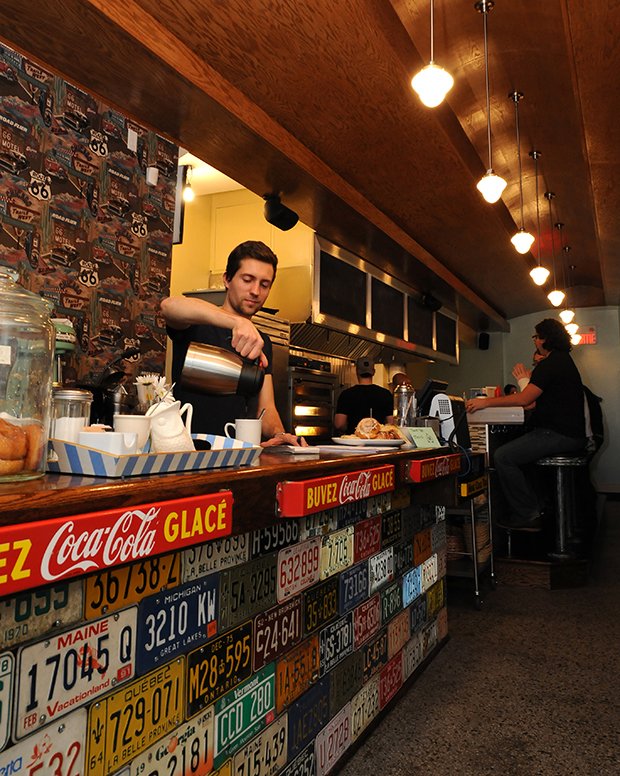
Le Gros Jambon opens early and closes late. Credit: Carrie MacPherson
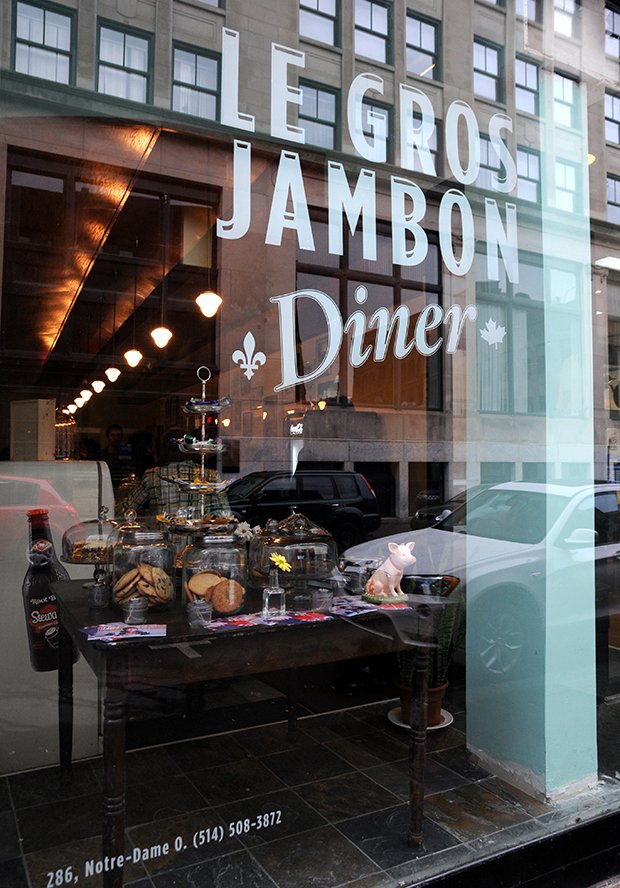
Le Gros Jambon Diner Credit: Carrie MacPherson
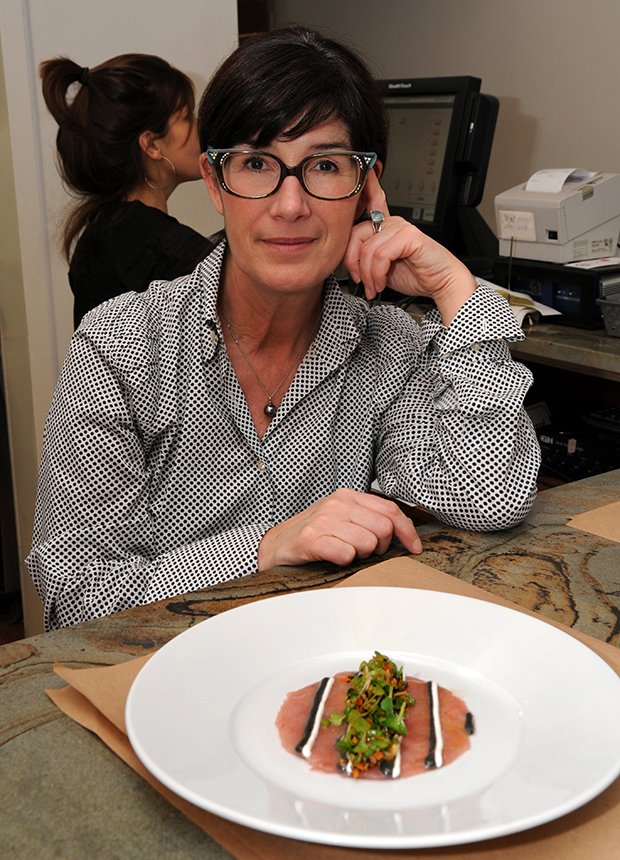
Van Horne co-owner Sylvie Lachance poses with a tuna tartare. Credit: Carrie MacPherson
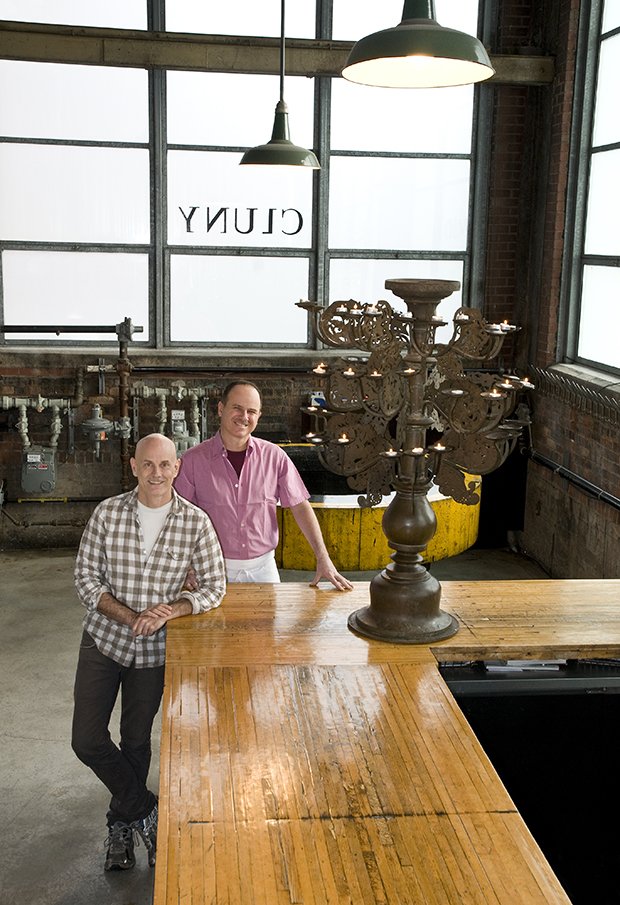
Patrick Meausette (in apron) and Rob Hack have turned a former foundry into Cluny ArtBar. Credit: Carrie MacPherson
A divine confluence of traditions blesses Montreal’s food scene.
For starters, there is the simple fact of French heritage and the corollary commitment to method, to professionalism and to pride in food well prepared and well served.
But other traditions would seem to fly in France’s face. These are the Québécois traits that give cuisine in the province’s largest city its character and charm — traits shared, interestingly, not with France but with Denmark.
These two societies, being small and folksy, share a communal culture where everyone likes to be on the same level. They take pride in jolly gregariousness and banishing hierarchies, romanticizing le p’tit gars, the little guy. In restaurants, this means a lovely sense of informal camaraderie, in stark contrast to the serious pecking orders of French cuisine.
They also share bad weather. Cold and dark for months on end, both places love comfortable and cozy interiors. Much of the joy of eating in Montreal and Copenhagen comes from warmth: warm and inviting hosts in warm and inviting environments.
In terms of the food itself, Montreal has become known in recent years for high-end reinventions of hearty peasant cuisine: comfort food for foodies.
Martin Picard, Quebec’s biggest celebrity chef, is widely believed to have kick-started the continent-wide fad for gourmet poutine variations.
His restaurant Au Pied de Cochon audaciously boasts an entire foie gras menu amongst heaps of meat and offal, including headcheese and a whole pig’s head for sharing. The duck confit comes in a can, from which it is famously plopped onto your plate, quivering gelatinously. Fries are cooked in duck fat, piglets are roasted to a crisp and the eponymous pig’s foot is served with still more foie gras.
Picard’s latest cookbook includes recipes for squirrel and beaver in which the head, tail or paws are saved for presentation oomph at the table.
But times are changing, and other chefs are branching out to include lighter and subtler food.
Eloi Dion, chef at Van Horne (1268 Ave Van Horne), is a master of melding delicate flavours into complex symphonies. His pan-seared pickerel is served in a subtle kombu daishi broth that incorporates the distinct flavours of bacon, soy, mirin and sake. His demi-glace involves roasting bones for three days to ensure all bitterness is banished. It’s a pure demi-glace, without the lily-gilding crutches of tomatoes or cherries.
Van Horne co-owner Sylvie Lachance provides the room’s charm. She is an engaging, quirky collector of art and eclectica. The restaurant houses some of her acquisitions, including the doors from the Iran Pavilion at Expo ’67 and a wall devoted to paper plates silkscreened by Roy Lichtenstein.
The restaurant is small and intimate. The tiny open kitchen suggests not the presentational pomp of a celebrity chef on display, but rather the sense that no one has thought to put up a door to contain the mayhem. It’s an amusing contrast to the tranquil dining room populated by tony patrons from nearby Outremont.
“I think if there is a trend it would be simplify rather than fancify popular dishes — that whole purity of the plain-but-quality ingredient,” says Patrick Meausette, who owns two restaurants — Cluny ArtBar and Titanic — with Rob Hack. “That is going on in other cities, too, but the Montreal twist is not to get fussy about it, to not keep raising the prices and the fancy names. I hate fancy, long-winded names for dishes — unless they are funny.”
Both restaurants occupy funky industrial spaces. Titanic (445 Rue St-Pierre) is in a former fur warehouse in Old Montreal, while Cluny (257 Rue Prince) shares an old foundry building with an art gallery.
“The new hit on our Titanic menu is scallopine Milanese,” Meausette reports. “Breaded pork pounded thin and deep-fried. We serve it in an onion-bread sandwich with a caper remoulade. No one bats an eye at a fried-meat sandwich. We try to keep it healthier by controlling the frying temperature, so there’s less oil absorbed, and serving it with spinach.”
“We have always done the idea of improving simple, almost ‘home,’ or at least ‘country,’ cooking and using Mediterranean ingredients, sometimes out of context. We take recipes we love and modernize them: bundt cake with olive oil, yogurt and lemon zest. Or I make bread pudding without bread and substitute day-old croissants and add rhubarb or dried cherries.”
Lesbian pastry chef Amy McKinnon, of Olive et Gourmando (351 Rue St-Paul Ouest) agrees. “The current trend in Montreal dessert is a combination of high-quality ingredients, unique flavour combinations and a sense of nostalgia. It’s pretty common to see desserts that your grandmother used to bake, only made with a twist. Whether that twist is a high-quality cocoa or an added flavour element, there’s a lot of interesting mixtures of old and new.”
“I think we’re all really interested in knowing where our ingredients come from and are willing to put the extra effort into making products completely from scratch. You’ll find a lot of places making their own cheeses, tonics, candies and breads.”
“The personal touch with dessert is another trend in Montreal baking right now,” McKinnon says. “It’s common to be served by the person who made your pastry. There are a lot of beautiful shops with a small staff or no staff at all in Montreal. Les Chocolats de Chloé, Cocoa Locale and Patisserie Rhubarbe are some of my favourites.”
At Titanic and Cluny, the personal touch goes on behind the scenes, too. “We have been a haven for many lost souls, people new to the city, people getting their footing,” Meausette says. “Many of our staff are new immigrants, and some of them have come out while working with us, so I guess we are a nurturing environment. I think the most important thing was to show them that it was normal to be gay or not and that they were accepted by their colleagues and the clients. Maybe some of the best thinking we have instilled has been with straight new immigrants who worked with us and who found a new understanding about gay people, which they admit they would never have had in their original countries.”
New & notable
Chuck Hughes is a celebrity chef, host of the Food Network show Chuck’s Day Off. Garde Manger, his inaugural restaurant, quickly became a destination in Old Montreal. Just around the corner, Hughes recently opened Le Bremner, which he describes as a “seafood diner.” Le Bremner (361 Rue St Paul Est) is informal and has a comfy back patio reminiscent of a cottage deck. The restaurant specializes in cocktails and sharing plates, which include giant fried oysters and mackerel escabèche with crème fraîche.
Le Gros Jambon (286 Rue Notre Dame Ouest) is a new hotspot in Old Montreal, open early and closing late. Try the Elvis sandwich: peanut butter and fried bananas inside grilled bread topped with chocolate sauce.
Nora Gray (1391 Rue St-Jacques) is a new darling of local food critics. Inventive Italian food and a thoughtful wine selection are wrapped in a sleek minimalist interior. Choose from wild-boar ragu over pumpkin ravioli or pistachio-stuffed leg of lamb with a side of kale gnudi.
For map locations and website links to almost 200 area places of interest see our gay Montreal listings pages.
On the web
Van Horne vanhornerestaurant.com
Le Bremner crownsalts.com/lebremner
Titanic titanicmontreal.com
Cluny ArtBar cluny.info
Olive et Gourmondo oliveetgourmando.com
Nora Gray noragray.com
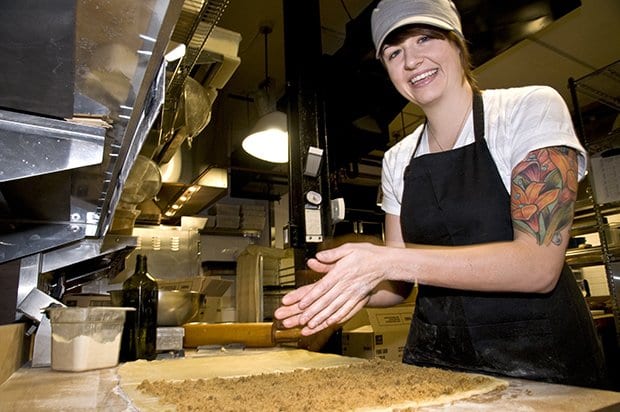
 Why you can trust Xtra
Why you can trust Xtra